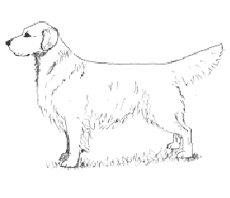Golden Retriever
General Information - Golden Retriever

Group:
Gundog
Size:
large
Lifespan:
10-13 years
Exercise:
medium
Grooming:
medium
Trainability:
very high
Watchdog ability:
medium
Protection ability:
low
Area of Origin:
Guisachan, North of Scotland
Date of Origin:
1800s
Other Names:
Yellow Retriever
Original Function:
retrieving
History
The Golden Retriever is a relatively young breed and only dates as far back as the mid-19th century. Developed by Lord Tweedmouth near the English-Scottish border, the Golden combines the blood of retriever, Tweed Water Spaniel, setter and the sandy-coloured Bloodhound. Goldens were first shown in UK in the early 1900's as Flat Coated Retrievers-Golden Variety. The Golden is a popular breed due to its well-mannered, friendly nature. It is also an excellent candidate for obedience training, and by instinct, is still a reliable, gentle-mouthed retriever. The Golden Retriever enjoys urban or rural settings as long as it is provided with plenty of outdoor exercise.
A few Goldens were imported into New Zealand in the 1940's, but it was not until the 1950's when some prominent English breeders emigrated to New Zealand, bringing their dogs with them, that the breed began to increase in popularity. From this time Goldens have gone from strength to strength. They are now one of the most popular breeds in the country.
Temperament
Kindly, friendly and confident.
Upkeep
The Golden Retriever needs daily exercise and human interaction. Challenging obedience lessons, active games or retrieving sessions are all good ways to exercise the Golden’s mind and body. Although it is capable of living outdoors, it is such a social dog that it is best when it shares its life with its family. The coat does not tend to mat but needs twice weekly brushing.
Golden Retriever
A breed standard is the guideline which describes the ideal characteristics, temperament, and appearance of a breed and ensures that the breed is fit for function with soundness essential. Breeders and judges should at all times be careful to avoid obvious conditions and exaggerations, as well as being mindful of features which could be detrimental in any way to the health, welfare or soundness of this breed.
Breed Standard - Golden Retriever
 General Appearance
General Appearance:Symmetrical, balanced, active, powerful, level mover; sound with kindly expression.
Characteristics: Biddable, intelligent and possessing natural working ability.
Temperament: Kindly, friendly and confident.
Head and Skull: Balanced and well chiselled, skull broad without coarseness; well set on neck, muzzle powerful, wide and deep. Length of foreface approximately equals length from well defined stop to occiput. Nose preferably black.
Eyes: Dark brown, set well apart, dark rims.
Ears: Moderate size, set on approximate level with eyes.
Mouth: Jaws strong, with a perfect, regular and complete scissor bite, i.e. upper teeth closely overlapping lower teeth and set square to the jaws.
Neck: Good length, clean and muscular.
Forequarters: Forelegs straight with good bone, shoulders well laid back, long in blade with upper arm of equal length placing legs well under body. Elbows close fitting.
Body: Balanced, short:coupled, deep through heart. Ribs deep, well sprung. Level topline.
Hindquarters: Loin and legs strong and muscular, good second thighs, well bent stifles. Hocks well let down, straight when viewed from rear, neither turning in nor out. Cow:hocks highly undesirable.
Feet: Round and cat:like.
Tail: Set on and carried level with back, reaching to hocks, without curl at tip.
Gait/movement: Powerful with good drive. Straight and true in front and rear. Stride long and free with no sign of hackney action in front.
Coat: Flat or wavy with good feathering, dense water:resisting undercoat.
Colour: Any shade of gold or cream, neither red nor mahogany. A few white hairs on chest only, permissible.
Size: Height At Withers - Dogs 56 - 61 cms (22 - 24 ins); bitches 51 - 56 cms (20 - 22 ins).
Faults: Any departure from the foregoing points should be considered a fault and the seriousness with which the fault should be regarded should be in exact proportion to its degree and its effect upon the health and welfare of the dog and on the dog’s ability to perform its traditional work.
Note: Male animals should have two apparently normal testicles fully descended into the scrotum.
DNZ No 320
Copyright Dogs New Zealand
24 Sept 2012
Any departure from the foregoing points should be considered a fault and the seriousness with which the fault should be regarded should be in exact proportion to its degree and its effect upon the health and welfare of the dog and on the dog’s ability to perform its traditional work.




